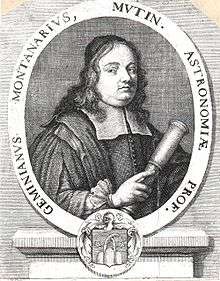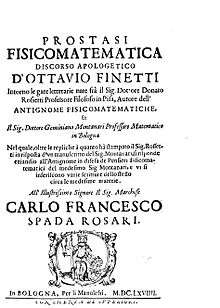Geminiano Montanari
Geminiano Montanari (1 June 1633 – 13 October 1687) was an Italian astronomer, lens-maker, and proponent of the experimental approach to science.

He is best known for his observation, made around 1667, that the second-brightest star (called Algol as derived from its name in Arabic) in the constellation of Perseus varied in brightness. It is likely that others had observed this effect before, but Montanari was the first named astronomer to record it. The star's names in Arabic, Hebrew and other languages, all of which have a meaning of "ghoul" or "demon", imply that its unusual behaviour had long been recognised.
Montanari was born in Modena, studied law in Florence, and graduated from the University of Salzburg. In 1662 or 1663 he moved to Bologna, where he drew an accurate map of the Moon using an ocular micrometer of his own making. He also made observations on capillarity and other problems in statics, and suggested that the viscosity of a liquid depended on the shape of its molecules. In 1669 he succeeded Giovanni Cassini as astronomy teacher at the University of Bologna[1] where one of his duties was to compile an astrological almanac. He did so in 1665, but perpetrated a deliberate hoax by writing the almanac entirely at random, to show that predictions made by chance were as likely to be fulfilled as those made by astrology. In the period shortly after Galileo Galilei, experimentalists like Montanari were engaged in a battle against the more mystical views of scientists such as Donato Rossetti.
On 21 March 1676 Montanari reported a sighting of a comet to Edmund Halley.
Montanari's observations of the great comet of 1680 are mentioned twice in the third volume of Newton's Principia.[2]
In 1679 Montanari moved to a teaching post in Padua, but almost all records of this period of his life have been lost. A letter survives from 1682 recording a sighting of Halley's Comet. He also wrote on economics, observing that demand for a particular commodity was fixed, and making comments on coinage and the value of money (1683).
A crater on the Moon, at 45.8S, 20.6W, is named after him.
Publications

- Pensieri fisico-matematici (1667)
- La Livella Diottrica (The Spirit Level) (1674)
- Trattato mercantile delle monete (1680)
- Montanari, Geminiano (1667). Pensieri fisico-matematici intorno diversi effetti de' liquidi in cannuccie di vetro e altri vasi. In Bologna: Emilio Maria & fratelli Manolessi. Retrieved 15 June 2015.
- Montanari, Geminiano (1669). Prostasi fisicomatematica. In Bologna: Emilio Maria & fratelli Manolessi. Retrieved 15 June 2015.
- Montanari, Geminiano (1671). Speculazioni fisiche sopra gli effetti di que' vetri temprati che rotti in una parte si risolvono in polvere. In Bologna: Emilio Maria & fratelli Manolessi. Retrieved 15 June 2015.
- Montanari, Geminiano (1676). Copia di lettera scritta all'illustrissimo Gio[vanni] Giuseppe Orsi. In Bologna: Emilio Maria & fratelli Manolessi. Retrieved 15 June 2015.
- Montanari, Geminiano (1676). Fiamma volante gran meteora veduta sopra l'Italia la sera del 31 marzo 1676. In Bologna: Emilio Maria & fratelli Manolessi. Retrieved 15 June 2015.
- Montanari, Geminiano (1678). Lezione academica havuta nell'Academia di s.a. reale in Torino il giorno 5 marzo 1678. In Torino, & in Bologna: Emilio Maria & fratelli Manolessi. Retrieved 15 June 2015.
- Montanari, Geminiano (1681). Copia di due lettere scritte all'illustrissimo signor Antonio Magliabechi sopra i moti, e le apparenze delle due comete ultimamente apparse sul fine di nouembre 1680, nelle costellazioni di Vergine e Libra, e sul fine di decembre in quella di Capricorno. Retrieved 15 June 2015.
- Montanari, Geminiano (1685). Astrologia convinta di falso col mezzo di nuove esperienze e ragioni fisico-astronomiche, o' sia La caccia del frugnuolo. In Venetia: Francesco Nicolini. Retrieved 15 June 2015.
- Montanari, Geminiano (1715). Discorso sopra la tromba parlante del signor dottore Geminiano Montanari professore delle matematiche in Padova. Aggiontovi un trattato postumo del mare Adriatico, e sua corrente esaminata, co la naturalezza de fiumi scoperta, e con nove forme di ripari corretta. In Venetia: per Girolamo Albrizzi.
References
- "Montanari, Geminiano". The Galileo Project. Rice University. Retrieved 8 August 2018.
- Isaac Newton, The Principia: Mathematical Principles of Natural Philosophy, edited by Bernard I. Cohen and Anne Whitman, Berkeley, University of California Press, 1999, pp. 913-915, 927.
Further reading
- Gómez López, Susana, Le passioni degli atomi. Montanari e Rossetti: Una polemica tra galileiani, Florence, Leo S. Olschki, 1997.
- Rotta, Sergio, 'Scienza e "pubblica felicità" in G. Montanari', in Miscellanea Seicento, Florence, Le Monnier, 1971, vol. 2, pp. 65-208.
- Vanzo, Alberto, 'Experiment and Speculation in Seventeenth-Century Italy: The Case of Geminiano Montanari', Studies in History and Philosophy of Science, 56 (2016), pp. 52-61.
External links
- Works by Geminiano Montanari at Project Gutenberg
- Works by or about Geminiano Montanari at Internet Archive
- "The impact of Galilean culture - From Bonaventura Cavalieri to Gian Domenico Cassini", Bologna University, Department of Astronomy, 2004-4-10.